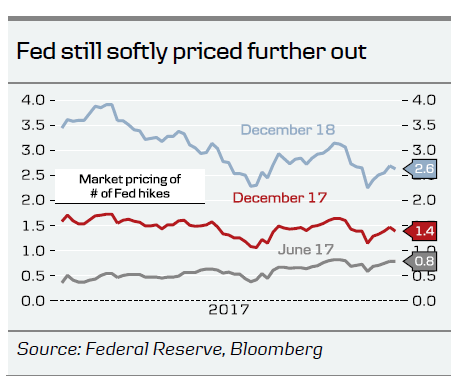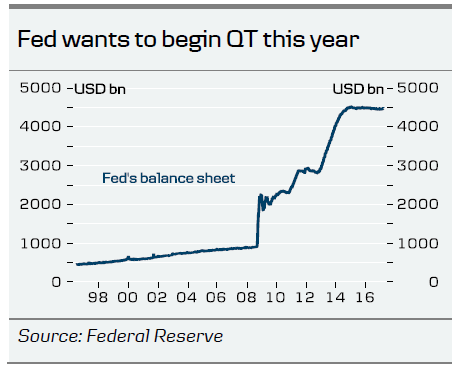On the rate hike outlook, ‘most participants’ (both covering voting and non-voting FOMC members) think a rate hike will be appropriate ‘soon’. As mentioned in the statement, the FOMC members were not worried about the weak GDP growth in Q1, which they think is transitory and partly reflecting negative residual seasonality. The members also noted that the unemployment rate had dropped further below the Fed’s NAIRU estimate of 4.7%. That said, ‘a few participants’ think it is a ‘concern’ that the progress on the inflation goal has slowed (and remember the meeting took place before the CPI data for April). Overall, the Fed admits it is in a difficult position. On the one hand the Fed should likely hike rates as it has met its employment objective; on the other, the Fed should be more cautious as it has missed its inflation target for eight years (except for a few months). Since the meeting, the problem has only worsened for the Fed. The jobs report for April showed the unemployment rate dipped to 4.4% (the lowest in a decade) while the CPI data for April surprised on the downside, as CPI core inflation dipped to 1.9% .
While consensus is that the Fed will hike at the June meeting, we are still more sceptical, because of both the weaker economic data and still too low inflation. However, we just think the Fed will wait until July, so it is not a given it should lead to a major reaction in the financial markets. Thus, it will not be a major surprise for us if the Fed decides to hike in June anyway, also given the current market pricing. By waiting until July, the Fed gets some more data points to ensure that inflation does not continue to surprise on the downside and that growth has rebounded in Q2 after the weak Q1. The reason why we think the Fed will still hike relatively soon is that it puts more weight on labour market data than inflation rates. Also, if the Fed hikes in June, it would indicate a hiking pace of four hikes per year (every other meeting), which is more than the Fed projected both in December and March (3 hikes per year). We expect the third hike this year to be in December.
Next year we now expect the Fed to hike three times (previously 3-4 times) due to a combination of the Fed’s desire to shrink its balance sheet soon (see section below and the next page) and Trump’s inability to deliver on Trumponomics (see analysis here).
Looking at the market pricing, we still think it is too the soft side. While the June hike is priced in by 80%, the markets have priced one and half hikes for the rest of the year and a total of 2.7 hikes from now until year-end 2018.
Fed outlines quantitative tightening principles
Before the release, we said we would look for any comments on the Fed’s desire to reduce the size of its balance sheet (quantitative tightening) and we were not left disappointed. ‘Nearly all’ FOMC members think it would be appropriate to begin quantitative tightening later this year (most have indicated in speech end-2017 is most likely).
The minutes state that quantitative tightening will be conducted ‘in a gradual and predictable manner’. The staff proposes that the FOMC announces a set of gradually increasing caps/limits on the dollar amounts of bonds that will be allowed to run off each month and only reinvest the amounts that exceeded the caps each month. The caps will be set at low levels and then raised every three months (corresponding to every other meeting, although the Fed will likely not vote on this every month, as many FOMC members have argued it should run in the background). When the final values of the caps are reached, the caps will be maintained and the balance sheet will continue to shrink until the target is reached.
The minutes also say that the FOMC members agreed to amend Committee’s Policy Normalization Principles and Plans “soon”. We are still missing the triggers for actually starting quantitative tightening (based on the minutes from the March meeting, ‘several participants’ prefer a quantitative threshold, which could be either a certain Fed funds target range or an economic variable (unemployment rate or inflation) like the previous Evans’s rule), caps sizes and increases and target for the future level of the balance sheet. The FOMC members agreed to continue the discussions at the June meeting.
We think this supports our view that the Fed will come with the big announcement of the triggers for starting quantitative tightening in connection with the June meeting. Although the Fed strongly signals the beginning of quantitative tightening this year, we hold onto our long-held view that it will actually start in Q1 18 for now. We expect the Fed to begin very gradually by a smaller amount than what the Fed bought per month under the QE1 programme (USD30bn per month) but with the idea of increasing caps the amount may rise above this threshold during the reduction phase. In an optimistic scenario the Fed can reduce its balance sheet by USD1,700bn, in our view.
We have written extensively about the QT theme this year: Fed’s Quantitative Tightening: Fixed Income Implications (6 April), FOMC Minutes: Quantitative tightening is moving closer (5 April) and Research US: Fed’s regulatory hurdle for starting quantitative tightening (13 March).
Recent US research
- Research US: Trump’s budget dead on arrival in Congress – do not expect too much of Trumponomics (24 May)
- FOMC review: Fed thinks weak GDP growth in Q1 was transitory (3 May)
- Fed’s Quantitative Tightening: Fixed Income Implications (6 April)
- FOMC Minutes: Quantitative tightening is moving closer (5 April)
- Research US: Fed’s regulatory hurdle for starting quantitative tightening (13 March)














